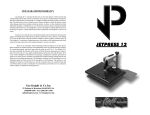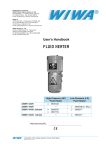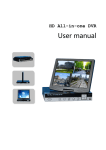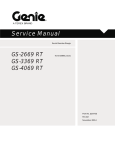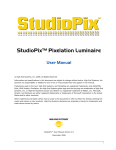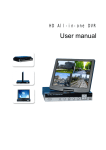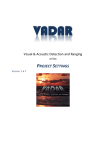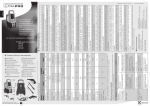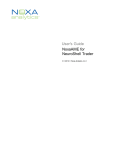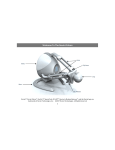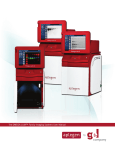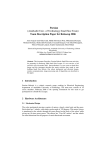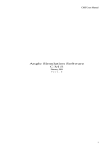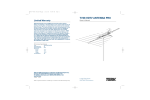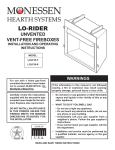Download INSPECTOWER 3 Getting Started Manual
Transcript
INSPECTOWER 3 Communication Tower Inspection Software Version 1.0.0 Getting Started with INSPECTOWER 3 A Computer Program for the Specialized Inspection and Mapping of Guyed Lattice Towers and Self-Supporting Lattice Towers, with Graphical Display of 2D Tower Elevation Profiles and Plans, with reference to US Standards TIA-222-G and TIA/EIA-222-F, Canadian Standard CAN/CSA-S37-01, and Australian Standard AU 3995:1994. INSPECTOWER 3 Copyright © 2009 Guymast Inc. All Rights Reserved. Limit of Liability This manual and the program it describes have been prepared with due care. The program has been tested and we are satisfied that it performs in accordance with the description contained in this manual. The user should know, however, that because of possible variances, neither Guymast Inc. nor its staff can assume responsibility for accuracy of results or for damages resulting from the use of this manual or the program described herein. Copyright INSPECTOWER and GUYMASTER are proprietary to Guymast Inc., which reserves all rights with respect to them. This publication may not be reproduced in whole or in part without prior written permission from Guymast Inc. INSPECTOWER, GUYMASTER, and this manual are Copyright © 2009 Guymast Inc. All Rights Reserved. GUYMASTER, GUYMAST-G, GUYMAST, MAST, MASTLOD, POLEMAST, POLELOD, DRAWFORCE, DRAWMAST, DRAWMAST3D, DISHFORCE, OUTRIG, and INSPECTOWER are trademarks of Guymast Inc. Safe-Net Inc. Sentinel Protection software and Sentinel and Sentinel Ultra-Pro hardware encryption keys are used under license from Safe-Net Inc. Microsoft Corp. Microsoft Office, Microsoft Excel, Microsoft Word, Microsoft Outlook, Microsoft Windowsxp, and Microsoft Windows Vista are trademarks of Microsoft Corp. FreeImage This software uses the FreeImage open source image library. See freeimage.sourceforge.net for details. FreeImage is used under the FreeImage Public License, version 1.0. INSPECTOWER 3 Copyright © 2009 Guymast Inc. All Rights Reserved. Table of Contents Page Table of Contents i Table of Figures iii 1 1 Welcome to INSPECTOWER 3 1.1 What’s New? ............................................................................................................................ 1 1.2 Licenses and Support ............................................................................................................... 1 1.2.1 Standalone License ................................................................................................................... 1 1.2.2 Network License ....................................................................................................................... 1 1.2.3 Support and Update Contracts ................................................................................................... 2 1.3 Information, Feedback, and Suggestions ................................................................................ 2 1.4 Training .................................................................................................................................... 2 1.5 Engineering Consultation ......................................................................................................... 3 2 Installation 5 2.1 License Protection Hardware Key and Driver .......................................................................... 5 2.2 Maintenance, Updates, and Upgrades ...................................................................................... 5 3 Getting Started with INSPECTOWER 3 7 3.1 Opening and Creating Projects ................................................................................................ 7 3.1.1 Open an existing project............................................................................................................ 7 3.1.2 Change the current Workspace .................................................................................................. 8 3.1.3 Create a new project ................................................................................................................. 8 3.2 Mapping a tower ...................................................................................................................... 9 3.2.1 Mast Geometry ....................................................................................................................... 10 3.2.2 Adding pictures for more detail ................................................................................................ 11 3.2.3 Mast Materials ........................................................................................................................ 12 3.2.4 Material Types ........................................................................................................................ 12 3.2.5 Another use for pictures .......................................................................................................... 13 3.2.6 Material Properties .................................................................................................................. 14 3.2.7 Guy Geometry ........................................................................................................................ 15 3.2.8 Congratulations! ..................................................................................................................... 15 3.3 Inspection .............................................................................................................................. 16 3.3.1 Transit Location ...................................................................................................................... 16 3.3.2 Transit Readings ..................................................................................................................... 17 3.3.3 Guy Assemblies ....................................................................................................................... 20 3.3.4 Guy Tensions .......................................................................................................................... 21 3.4 Reports ................................................................................................................................... 21 i INSPECTOWER 3 Copyright © 2009 Guymast Inc. All Rights Reserved. Table of Contents (continued) Page 4 Appendix A: Example Inspection Report 23 4.1 Tower Verticality and Straightness .........................................................................................23 4.2 Tower Twist.............................................................................................................................23 4.3 Measured Guy Tensions ..........................................................................................................24 4.4 Measured Turnbuckle Gaps .....................................................................................................24 5 Appendix B: Example Tower Drawing (Draw Tower) ii INSPECTOWER 3 Copyright © 2009 Guymast Inc. All Rights Reserved. 25 Table of Figures Figure Figure Figure Figure Figure Figure Figure Figure Figure Figure Figure Figure Figure Figure Figure Figure Figure Figure Figure Figure Figure Page 1 — SafeNet Inc.'s Sentinel UltraPro and Sentinel USB Keys ..............................................................5 2 — Project and Workspace Manager ...............................................................................................7 3 — Working with Workspaces ........................................................................................................8 4 — Starting a new project — step 1................................................................................................8 5 — Starting a new project — step 2 — Project Properties — Main tab ...............................................9 6 — Starting a new project — step 3 — Project Properties — Project ID tab .......................................9 7 — Describing Mast Geometry ...................................................................................................... 10 8 — Including pictures for greater clarity and more complete mapping ............................................ 11 9 — Specifying the material used for various mast elements in the tower ......................................... 12 10 — Material Types used for mast elements and appurtenances .................................................... 13 11 —Store an image of a useful table found online ......................................................................... 13 12 — Some Material Properties ...................................................................................................... 14 13 — Guy Geometry information to be entered ............................................................................... 15 14 — Transit Location measurements ............................................................................................ 16 15 — Transit Readings .................................................................................................................. 17 16 — Anchor Location by Transit ................................................................................................... 18 17 — Mast Alignment and Deflections by Transit ............................................................................ 19 18 — Guy Assemblies as recorded during mapping and inspection ................................................... 20 19 — Guy Tension measurements .................................................................................................. 21 20 — Report types ........................................................................................................................ 21 21 — Example Draw Tower tower drawing ..................................................................................... 25 iii INSPECTOWER 3 Copyright © 2009 Guymast Inc. All Rights Reserved. 1 Welcome to INSPECTOWER 3 INSPECTOWER 3 is a powerful tool for the calculation of values associated with the inspection of latticed towers, both guyed and self-supporting. 1.1 What’s New? INSPECTOWER has undergone many significant changes since its last version. With INSPECTOWER 3 you can map towers, which can then be viewed in profile and plan drawings. This data can be imported into GUYMASTER, Guymast Inc.’s powerful tower analysis software for use in engineering with little or no additional data needed, saving time and money. INSPECTOWER 3 is the best software available for tower inspection. 1.2 Licenses and Support 1.2.1 Standalone License A standalone license permits use of a single copy of INSPECTOWER 3 on a single computer with a single hardware key. Multiple copies of the software may be installed anywhere desired, but only one can be in use at a given time, as the software will only run if the key is installed on that computer. Multiple standalone licenses may be used, each with their own key. 1.2.2 Network License A network license permits use of one or more copies of INSPECTOWER 3 anywhere on a network at any given time. For example, with a network license for 5 copies, up to 5 users can be logged on at any given moment with a single hardware key, permitting access to those 5 licenses from the network server. ! It should be kept in mind that a network license allows access to the software more conveniently for more of the company’s users over the working day, from a centrally administrated position; however, if you want to take your computer with you, you will still need a 1.2.1 Standalone License and its hardware key. 1 INSPECTOWER 3 Copyright © 2009 Guymast Inc. All Rights Reserved. 1 Welcome to INSPECTOWER 3 (continued) 1.2.3 Support and Update Contracts With your initial purchase of INSPECTOWER 3, you are entitled to one year of technical support and all software updates of INSPECTOWER 3 produced during that time. Payment of the annual maintenance fee extends this support beyond the initial support period. For help with installation and use of INSPECTOWER 3 and related products, Guymast Inc. can be contacted at the email address and phone number below. Tel.: 416-736-7453 Technical Support email: [email protected] ! As updates and information will be provided by Guymast Inc. via email for the most part, please keep us informed of any changes in contact information so that we can keep you informed of important updates or upcoming expiry of your support contract(s). 1.3 Information, Feedback, and Suggestions Guymast Inc. welcomes feedback and suggestions and we would love to show you our other products and services. Tell us how we can serve you better, and feel free to tell us how we could do it better. If you have a particular need we can arrange to fulfill it either with customized programming contracts or extensions of existing products. We will always do our best to earn your business. Contact Guymast Inc. at: Guymast Inc. 1110 Finch Ave. West, Suite 814 Toronto, ON, Canada M3J 2T2 Tel.: 416-736-7453 email: [email protected] 1.4 Training Guymast Inc. provides customized training sessions on our software in particular and tower engineering in general, working with your company’s current projects for better learning and allowing you to complete part of the project’s objectives during the training session. You can come to us or we can come to you! 2 INSPECTOWER 3 Copyright © 2009 Guymast Inc. All Rights Reserved. 1 Welcome to INSPECTOWER 3 (continued) 1.5 Engineering Consultation Our sister company, Weisman Consultants Inc., is happy to provide engineering consultation for specific issues and tower engineering in general. They may be consulted on questions that go significantly beyond the scope of technical support for the software itself. Contact Weisman Consultants Inc. at: Weisman Consultants Inc. 1110 Finch Ave. West, Suite 814 Toronto, ON, Canada M3J 2T2 Tel.: 416-736-7453 email: [email protected] 3 INSPECTOWER 3 Copyright © 2009 Guymast Inc. All Rights Reserved. 2 Installation The installation process for INSPECTOWER 3 has been constructed to be as simple as possible. 1. Run the SETUP program from the CD or the download location and follow the on-screen step-by-step instructions. 2. Partway through, the Sentinel Key installer program will execute. Follow those on-screen instructions as well. Answer “Yes” when asked about adding network support if using network security keys. 3. Insert USB Security Key. 4. Run INSPECTOWER 3 from the Start menu or other shortcut. 2.1 License Protection Hardware Key and Driver SafeNet Inc.’s Sentinel UltraPro and Sentinel USB keys (Figure 1 below) and driver must be installed properly in order for INSPECTOWER 3 to work. Figure 1 — SafeNet Inc.'s Sentinel UltraPro and Sentinel USB Keys (Source: www.safenet-inc.com) ! Do not insert the key into your computer before installing the driver software. The Sentinel hardware keys and the device drivers are provided under license from SafeNet Inc. Guymast Inc. is not responsible for damages or losses resulting from their use. Read the terms of the license agreement in the displayed screen in the 2 Installation process. 2.2 Maintenance, Updates, and Upgrades INSPECTOWER 3 should run maintenance-free. When there are updates or upgrades available, Guymast Inc. will provide up-to-date information through the automatic update notification system in the program. Please feel free to 1.2.3 Contact Us for further support and with questions about updates and changes. 5 INSPECTOWER 3 Copyright © 2009 Guymast Inc. All Rights Reserved. 3 Getting Started with INSPECTOWER 3 (continued) 3 Getting Started with INSPECTOWER 3 3.1 Opening and Creating Projects Every time you activate INSPECTOWER 3 you will see the current Workspace and the projects contained in it (Figure 2 below). Figure 2 — Project and Workspace Manager 3.1.1 Open an existing project Select a project and open it to start working on it. Save As… from the Project menu and give a new name to create a copy of a project. The original is retained. ! Experiment with the example project that ships with INSPECTOWER 3. 7 INSPECTOWER 3 Copyright © 2009 Guymast Inc. All Rights Reserved. 3 Getting Started with INSPECTOWER 3 (continued) 3.1.2 Change the current Workspace You may wish to change the Workspace you are working in (Figure 3 below). Figure 3 — Working with Workspaces 3.1.3 Create a new project You can start a new project in the active Workspace at any time (Figure 4 below). Figure 4 — Starting a new project — step 1 8 INSPECTOWER 3 Copyright © 2009 Guymast Inc. All Rights Reserved. 3 Getting Started with INSPECTOWER 3 (continued) Enter important properties into the Main tab of the New Project or Project Properties dialog boxes (Figure 5 below) and further Project ID information (Figure 6 below). ! Be sure to fill in an appropriate project name and Design Temperature on the Main tab. Figure 5 — Starting a new project — step 2 — Project Properties — Main tab Figure 6 — Starting a new project — step 3 — Project Properties — Project ID tab The Project ID information will be automatically transferred to the report generated by INSPECTOWER 3, and can be helpful in identifying data and reports. ! The Parameters tab is included to provide advanced specifications and for compatibility with GUYMASTER data formats. It is recommended for advanced users. Explore it as you get more familiar with the software. 3.2 Mapping a tower Tower Mapping entries provide information that INSPECTOWER 3 uses to do calculations, to generate reports, and to draw the tower profile. Of course, this information is useful for describing the tower for other purposes, especially including for possible analysis using GUYMASTER, which shares the same data format and thus doesn’t require re-entry of data. Start by describing the 3.2.1 Mast Geometry. 9 INSPECTOWER 3 Copyright © 2009 Guymast Inc. All Rights Reserved. 3 Getting Started with INSPECTOWER 3 (continued) 3.2.1 Mast Geometry Click on LATTICE MAST GEOMETRY in the Table List to the left (Figure 7 below): you will bring the MAST GEOMETRY table to the front. Fill in the data as required. Note that data can be put in one panel at a time, but it is often more practical to put it in by regions of the tower’s face width in which the values are constant or where there is a straight line transition from the BOTTOM ELEVATION to the TOP ELEVATION of the region. Also, PANEL TYPE, NO OF LEGS, SUB DIVIDE, and PANEL HEIGHT must be constant for any one region defined in any one line of data. The inspector can simply measure every panel and enter the values to end up with the whole tower. It should be noted, however, that the length of the section must exactly equal the sum of the heights of all the panels in the section. In some cases the typical panel height or that of the two end panels in the section may have to be adjusted to give the correct section length. Figure 7 — Describing Mast Geometry 10 INSPECTOWER 3 Copyright © 2009 Guymast Inc. All Rights Reserved. 3 Getting Started with INSPECTOWER 3 (continued) 3.2.2 Adding pictures for more detail All sorts of pictures can be added to illustrate the data (Figure 8 below). Figure 8 — Including pictures for greater clarity and more complete mapping ! Having more information available than the data tables provide for is useful and can be achieved by using pictures or other resources stored in the picture manager. ! Pictures can provide extra information. For example: the site is an open field with tall grass, surrounded by brush and trees. There was no snow at the time of inspection, there is a square concrete pier under the tower which can be scaled from a photograph to obtain dimensions, etc. 11 INSPECTOWER 3 Copyright © 2009 Guymast Inc. All Rights Reserved. 3 Getting Started with INSPECTOWER 3 (continued) 3.2.3 Mast Materials Indicate the materials used for each mast element (Figure 9 below) typical for a given region of the tower. Figure 9 — Specifying the material used for various mast elements in the tower 3.2.4 Material Types Create a bill of materials in the MATERIAL TYPES table (Figure 11 below). You may define these materials, based on the typical shapes, or you may get them from the Structural Shapes database under the Tools menu. More details will be made available in the full user manual. ! Each material type has an ID number. These ID numbers are used in other tables to indicate that a certain component or element is made of that specific material type. With this system, you only ever have to specify this kind of data once, saving you time! ! If you are not referencing the TIA-222-G standard, then the Material Types table will have two fewer columns and the Unit Weight of material will be in place of Flange Thickness. 12 INSPECTOWER 3 Copyright © 2009 Guymast Inc. All Rights Reserved. 3 Getting Started with INSPECTOWER 3 (continued) Figure 10 — Material Types used for mast elements and appurtenances 3.2.5 Another use for pictures Take a screen shot image (Print Screen/Prt Scr and Paste into Microsoft Paint or other image editor) of a useful table you may wish to refer to, and link it with some portion of your project (such as pipe thicknesses in Figure 11 below). Figure 11 —Store an image of a useful table found online 13 INSPECTOWER 3 Copyright © 2009 Guymast Inc. All Rights Reserved. 3 Getting Started with INSPECTOWER 3 (continued) 3.2.6 Material Properties ! The Material Properties table is used only in case standard TIA-222-G is specified. For completeness, MATERIAL PROPERTIES need to be added. If you are only doing an inspection and mapping, but not analysis, then you can just copy the properties from Figure 12 below. Figure 12 — Some Material Properties ! 14 INSPECTOWER 3 Copyright © 2009 Guymast Inc. All Rights Reserved. Material Properties complete the definition of Materials, but are only used in Analysis. 3 Getting Started with INSPECTOWER 3 (continued) 3.2.7 Guy Geometry For guyed towers, GUY GEOMETRY must be included (Figure 13 below). This comes from measurements in the field for mapping, or from drawings. Data in TRANSIT LOCATION in the 3.3 Inspection process generates the RADIUS component. ELEVation of guy on mast comes from the height of the guy connection above the base of the tower. Height is the sum of ELEV and the drop of the anchor below the tower base. MAST ATTACH RADIUS is the distance from the center of the tower to the point on the mast where the guy actually connects. ATTACH AZI is the direction of the ATTACH RADIUS. Figure 13 — Guy Geometry information to be entered 3.2.8 Congratulations! You have just finished the minimum mapping required to establish the tower geometry, construction, and guy system definition. Clicking on Draw Tower, causes INSPECTOWER 3 to draw the profile of the tower, which can be made part of the printed report and is available for analysis if desired. The analysis, itself, has to be done in GUYMASTER, a separate software package that reads the data prepared in INSPECTOWER 3, so double entry of data is not necessary. Please visit www.guymast.com for more information, or feel free to call or email us! (Contact information in 1.3 Information, Feedback, and Suggestions above) 15 INSPECTOWER 3 Copyright © 2009 Guymast Inc. All Rights Reserved. 3 Getting Started with INSPECTOWER 3 (continued) 3.3 Inspection A tower’s basic structure is mapped as above in 3.2 Mapping a tower. Field measurements taken during an inspection are entered into INSPECTION INPUT tables, allowing calculating and reporting on alignment, verticality, twist, and measured guy tensions. 3.3.1 Transit Location Start with the TRANSIT LOCATION table (Figure 14 below). Except for selfsupporting towers, the transit (theodolite) is usually placed near a guy anchor, because that is where you will get a clear view of the tower, and because you need to inspect the guy anchor as well. ! If the inspector is unclear on where to place the transit or has a particularly tricky set-up, please contact us for 1.3 Information, 1.4 Training, and 1.5 Engineering Consultation. Figure 14 — Transit Location measurements Values recording the distances from instrument to anchor and the vertical angle readings taken on the tower, establish the exact position of the anchor with respect to the tower base. These are used to calculate anchor radius and guy lengths. 16 INSPECTOWER 3 Copyright © 2009 Guymast Inc. All Rights Reserved. 3 Getting Started with INSPECTOWER 3 (continued) 3.3.2 Transit Readings The TRANSIT READINGS table (Figure 15 below) combines readings for anchor location in columns 2 and 3, and readings for tower alignment in columns 2, 4, 5, and 6. See detailed description in the full user manual for how to take readings. Figure 15 — Transit Readings You may choose to enter only one type of data or both, which is recommended for making the process more routine and, therefore, more likely to be done properly and completely in all cases and for all future purposes. 17 INSPECTOWER 3 Copyright © 2009 Guymast Inc. All Rights Reserved. 3 Getting Started with INSPECTOWER 3 (continued) Figure 16 — Anchor Location by Transit Although the readings of vertical angles used for calculating anchor location would be sufficient if taken at only two elevations, by providing more than two elevations you include information that can be used for averaging out errors and reporting on the likely reliability of the data. 18 INSPECTOWER 3 Copyright © 2009 Guymast Inc. All Rights Reserved. 3 Getting Started with INSPECTOWER 3 (continued) Figure 17 (below) shows the concept of estimating tower verticality, twist, and deflection at any elevation by comparing to the position of the tower legs at the base. The figure shows what measurements are needed at each elevation in order to establish deflection and rotation at the selected elevations. Figure 17 — Mast Alignment and Deflections by Transit 19 INSPECTOWER 3 Copyright © 2009 Guymast Inc. All Rights Reserved. 3 Getting Started with INSPECTOWER 3 (continued) You start by locating the instrument on a guy line or on the extended radial from the center of the tower passing through the nearest leg at the lowest point on the tower that can be seen from the instrument’s position. This Transit Location is typically behind the outer guy anchor at a distance that will make it possible to observe the legs at the top of the tower. Level the Instrument and center it on the nearest leg at the bottom. Tilt the telescope up to the next level to be observed and estimate the fraction of the visible leg diameter by which the center of the leg has moved from the vertical transit crosshair, positive to the right, negative to the left. Do this for every elevation of interest, and at the same time record the vertical angle to that known elevation (a section splice is best). When all elevations have been observed and recorded, invert the telescope, rotate it horizontally by 180° and repeat the readings. This repetition will remove the error in readings due to an error in the level of the instrument. Do these steps for each of the three or four radials through the tower legs. INSPECTOWER 3 automatically does the necessary calculations to give you the results when you activate the Inspection Report function (section 3.4 below). ! Leg diameter dimensions will be taken from the mapping data that had been entered in the 3.2.1 Mast Geometry, 3.2.3 Mast Materials, and 3.2.4 Material Types tables. 3.3.3 Guy Assemblies The recording of GUY ASSEMBLIES (Figure 18 below) is self explanatory. The purpose in mapping is to inform the record; in inspections, it is to see what changes may have taken place. Simply measure and assess the status of the Guy Assemblies’ components and fill in the table appropriately. Figure 18 — Guy Assemblies as recorded during mapping and inspection 20 INSPECTOWER 3 Copyright © 2009 Guymast Inc. All Rights Reserved. 3 Getting Started with INSPECTOWER 3 (continued) 3.3.4 Guy Tensions The last table of the inspection measurements is that of GUY TENSIONS (Figure 19 below). In the example the swing method was used to estimate the guy tension, but as can be seen in the drop down to the left, the inspector can also use the pulse method, the tangent intercept and a direct reading with the Smart-Guy tension meter or the Penn-Tech or Dillon meters. Figure 19 — Guy Tension measurements 3.4 Reports Figure 20 — Report types INSPECTOWER 3 creates three kinds of reports (Figure 20 above): Inspection reports with data on Verticality and Temperature-Adjusted Tension, for example, and more (4 Appendix A: Example Inspection Report); Tower Mapping drawings in plan and elevation views (5 Appendix B: Example Tower Drawing (Draw Tower)); and Calculations Reports providing a record of the activity in the calculator tables for the project. 21 INSPECTOWER 3 Copyright © 2009 Guymast Inc. All Rights Reserved. 4 Appendix A: Example Inspection Report (continued) 4 Appendix A: Example Inspection Report The following is an example of the tower Inspection Report tables generated, covering the important results needed for a typical tower inspection. ! The report file format is generated in highly compatible RTF (Rich Text Format). 100 ft guyed tower in Buffalo Date Built: 5/15/2007 Date Last Modified: 10/29/2009 Client: The Smartest Consultant, Inc Owner: The Biggest Tower Company Location: Buffalo NY Comment: This was a tough one! 4.1 Tower Verticality and Straightness Reference Elevation Deviation along Axis 1 Deviation along Axis 2 Verticality Resultant Allowable Deviation Resultant Deviation ft 100.00 in -0.11 in 1.44 in 1.44 in 3.00 68.80 0.05 1.22 1.22 2.06 35.00 -0.32 0.81 0.88 1.05 0.00 0.00 0.00 0.00 0.00 Straightness Resultant Allowable Deviation Deviation between between Elevations Elevations in in 0.27 0.94 0.56 1.01 0.88 1.05 4.2 Tower Twist Reference Elevation Twist wrt Base Allowable Twist wrt Base ft 100.00 degrees -0.34 +/- degrees 5.00 68.80 0.52 3.44 35.00 -3.79 1.75 0.00 0.00 0.00 Relative Twist between Reference Points degrees Allowable Twist between Reference Points +/- degrees 0.86 1.56 4.31 1.69 -3.79 1.75 23 INSPECTOWER 3 Copyright © 2009 Guymast Inc. All Rights Reserved. 4 Appendix A: Example Inspection Report (continued) 4.3 Measured Guy Tensions Guy Line Guy Elevation ft 100.00 68.75 35.00 2 100.00 68.75 35.00 3 100.00 68.75 35.00 * outside allowable range 1 Guy Diameter Measured Tension at 24°C kips 0.71 0.38 0.65 0.81 0.46 0.51 0.74 0.31 0.55 3/8'' GS 1/4'' GS 1/4'' GS 3/8'' GS 1/4'' GS 1/4'' GS 3/8'' GS 1/4'' GS 1/4'' GS Measured Tension adjusted to 10°C kips 0.84* 0.47* 0.79* 0.95* 0.55* 0.64 0.88* 0.41* 0.69 Design Initial Tension at 10°C Range of Tensions Allowable kips 1.35 0.65 0.65 1.35 0.65 0.65 1.35 0.65 0.65 kips 1.22 - 1.49 0.59 - 0.72 0.59 - 0.72 1.22 - 1.49 0.59 - 0.72 0.59 - 0.72 1.22 - 1.49 0.59 - 0.72 0.59 - 0.72 4.4 Measured Turnbuckle Gaps Guy Line Guy Elevation ft 100.0 68.8 35.0 2 100.0 68.8 35.0 3 100.0 68.8 35.0 * outside allowable range 1 Shackle Size in 1/2 7/16 7/16 1/2 7/16 7/16 1/2 7/16 7/16 Turnbuckle Size in 5/8 x 12 1/2 x 12 1/2 x 12 5/8 x 12 1/2 x 12 1/2 x 12 5/8 x 12 1/2 x 12 1/2 x 12 Gap Measured in 5-1/2 7-1/2 5-1/4 4 8-1/4* 6-1/2 5-1/4 7-1/4 5-3/4 Desirable Range in 4-8 4-8 4-8 4-8 4-8 4-8 4-8 4-8 4-8 Suggested Adjustment in -0.47 0.00 -0.30 -0.43 -0.23 -0.44 -0.47 -0.41 -0.40 ! Note suggested Turnbuckle Adjustments automatically calculated. These are the adjustments to be made to the turnbuckle gaps in order to bring alignment and guy tension within the specified limits. ! Applying these adjustments may not make the tower perfectly straight or all tensions exactly as desired, but should bring these within acceptable limits. 24 INSPECTOWER 3 Copyright © 2009 Guymast Inc. All Rights Reserved. 5 Appendix B: Example Tower Drawing (Draw Tower) (continued) 5 Appendix B: Example Tower Drawing (Draw Tower) These material properties can come from the tables for G Draw Tower opens DRAWMAST, our tower drawing tool, included with INSPECTOWER 3. This tool has a great many options and powerful features and can show vertical sections of the tower, zoom in and around, and even show slices of the tower. The full instructions will be included in the main instruction manual. Figure 21 — Example Draw Tower tower drawing A full page (blown up) example of Figure 21 above is provided on the next page. Note that the significant dimensions, patterns, and matierals used in the tower are included in the profile drawing. The title block travels with the drawing showing who generated the drawing. If the inspector has gone to the trouble of entering details of antennas, lights, ladders, tx-lines, and more, as he should in a proper mapping, these items will be shown on the drawing. 25 INSPECTOWER 3 Copyright © 2009 Guymast Inc. All Rights Reserved. These material properties can come from the tables for G 5 Appendix B: Example Tower Drawing (Draw Tower) (continued) 26 INSPECTOWER 3 Copyright © 2009 Guymast Inc. All Rights Reserved.

































